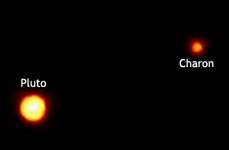
Despite being only 0.9 arcsecond apart, Pluto and its largest moon, Charon, appear well separated in this Hubble Space Telescope image snapped on February 21, 1994. While Pluto has now received an asteroid number, its companion satellites have not.
Without fanfare, the September 7th batch of circulars from the Minor Planet Center assigns number 134340 to Pluto. This action brings Pluto into the ranks of small solar-system bodies having accurately known orbits — the same roster that starts with 1 Ceres, 2 Pallas, 3 Juno, 4 Vesta, and so on. The list includes such famous objects as 433 Eros, 1862 Apollo, 3200 Phaethon, and 50000 Quaoar.
Pluto’s numbering comes close on the heels of the International Astronomical Union’s recent vote about the definition of a planet. Pluto needs six digits because of the explosive rate of numberings in just the past decade. (At the end of 1996, the highest-numbered asteroid was 7367 Giotto!) The September circulars also provide numbers, but not official names, for three other large trans-Neptunian objects: 136199 goes to 2003 UB313, 136108 to 2003 EL61, and 136472 to 2005 FY9.
In a separate notice issued by the Minor Planet Center the same day, Timothy B. Spahr comments that assigning permanent numbers to these large, faraway objects “does not preclude their having dual designations in possible separate catalogues of such bodies.” Spahr is interim director of the center following last month’s retirement of Brian G. Marsden, who had served as director since 1978.
 0
0
Comments
You must be logged in to post a comment.